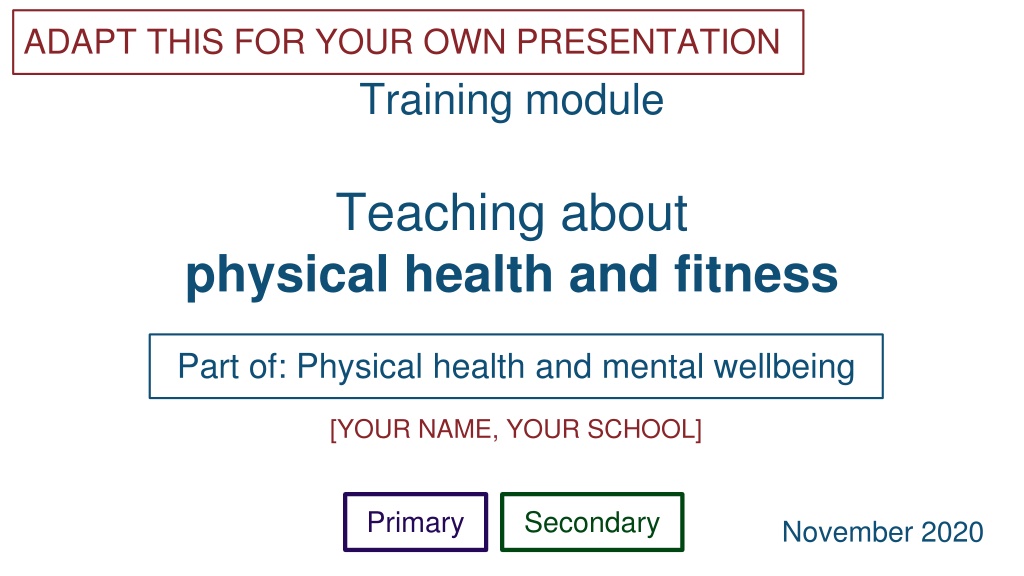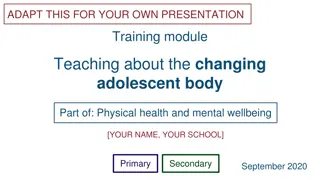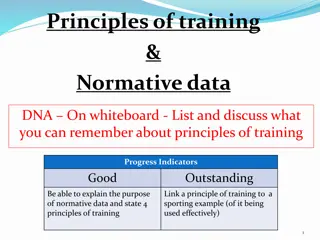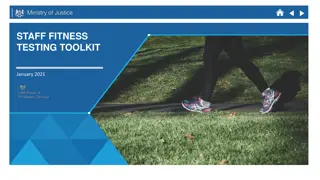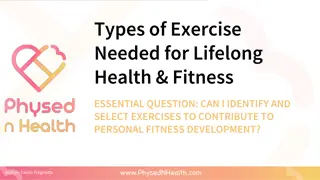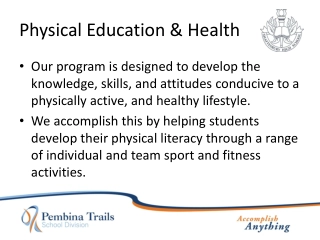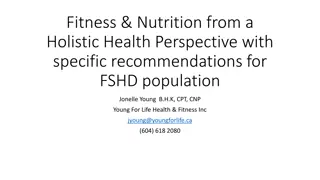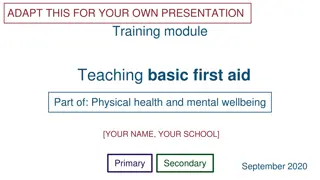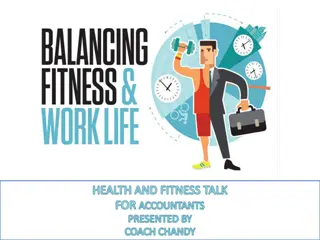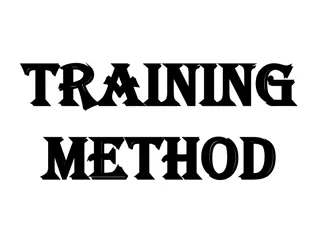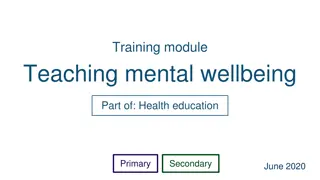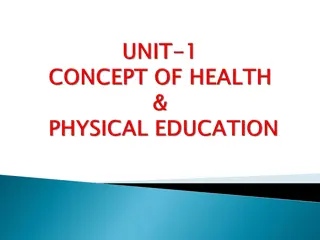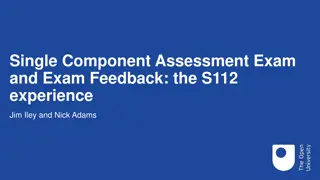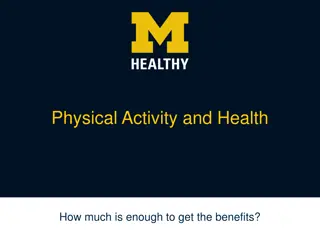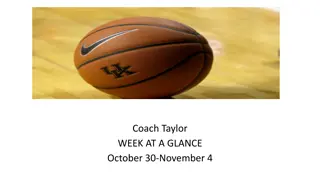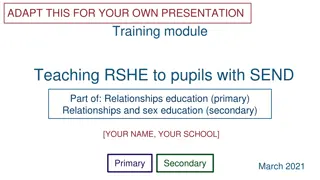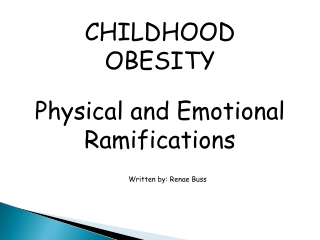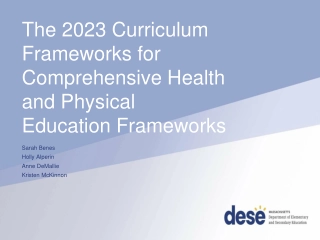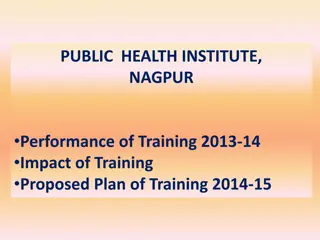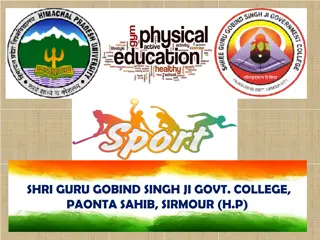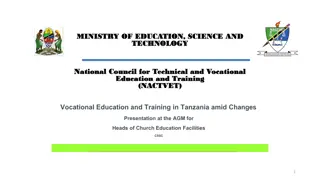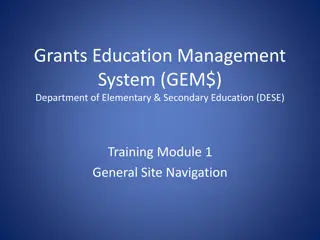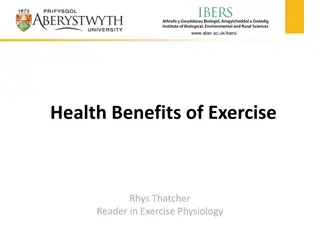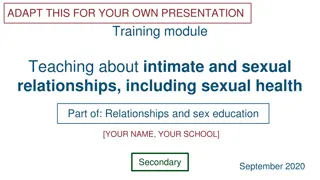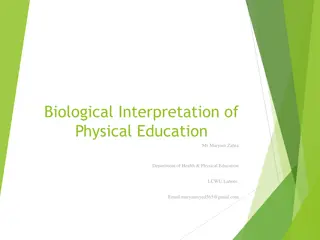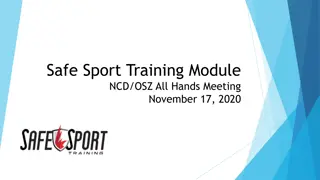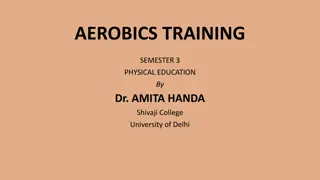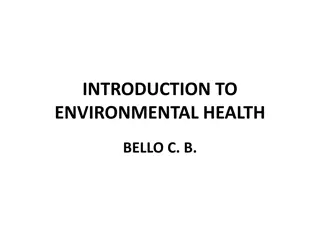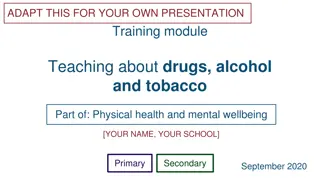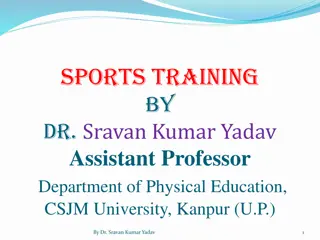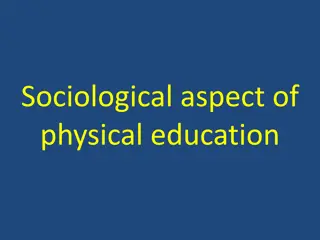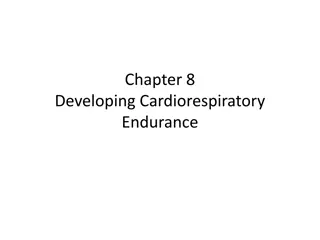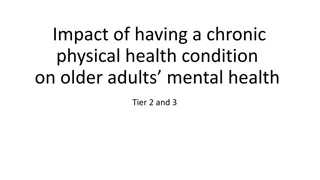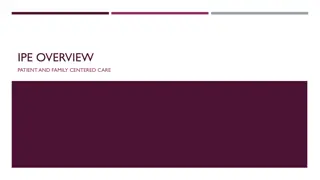Enhancing Physical Health and Fitness Education: A Comprehensive Training Module
This training module focuses on teaching about physical health and fitness, promoting mental wellbeing in primary and secondary schools. It covers curriculum guidance, safeguarding measures, ground rules, and examples of good practice, offering activities and templates for trainers. Attendees will gain knowledge, facts, and strategies to confidently teach this topic. Related topics, such as healthy eating and mental wellbeing, are also explored, emphasizing thematic links across key subjects. School-specific support, policies, and specialist resources are highlighted, supporting schools in implementing effective physical health and fitness education programs.
Download Presentation

Please find below an Image/Link to download the presentation.
The content on the website is provided AS IS for your information and personal use only. It may not be sold, licensed, or shared on other websites without obtaining consent from the author. Download presentation by click this link. If you encounter any issues during the download, it is possible that the publisher has removed the file from their server.
E N D
Presentation Transcript
ADAPT THIS FOR YOUR OWN PRESENTATION Training module Teaching about physical health and fitness Part of: Physical health and mental wellbeing [YOUR NAME, YOUR SCHOOL] Primary Secondary November 2020
Contents 3 About this training module 5 Teaching the new curriculum 11 Safeguarding 14 Ground rules 17 Primary curriculum 35 Secondary curriculum 66 Examples of good practice 74 Activities and templates for trainers 2
About this training module Subject leads can use the adaptable slides and activities and templates for trainers section at the end of this module to help shape training sessions for teachers. This non-statutory training module supplements the statutory guidance on teaching about physical health and fitness, which schools should read in full. Schools can choose whether and how to follow or adapt this training module and should refer to the Early Career Framework for pedagogical guidance. 3
What you get out of today By the end of this training you should: know what is included in the statutory guidance know some key knowledge and facts to cover as part of this topic have strategies to deal with questions that come up in class feel more confident teaching about physical health and fitness 4
Related topics Physical health and fitness is closely related to the physical education programmes of study as well as to the modules: health and prevention healthy eating mental wellbeing intimate relationships including sexual health Therefore you should: consider thematic links across key topics and the whole school when planning and delivering lessons find ways to link knowledge and vocabulary across topics 6
Physical health and fitness support at [school name] Our leads [Names, contact details] Our policies [Add details - e.g. relevant school policy] Specialist support [Add details - e.g. providers school already works with] Other information [Add resources] 7
Teaching about physical health and fitness at [school name] Ways in which we already teach about physical health and fitness at our school: [Add details] [Add details] [Add details] 8
Primary and secondary teaching Some slides in this training have a Primary or Secondary label to indicate that the material is usually first introduced in that phase. STATUTORY GUIDANCE Schools have flexibility to design and plan age-appropriate subject content. (p31) Using your knowledge of your pupils and school community you can: introduce secondary content in primary with pupils who need it and are ready teach the primary content in early secondary lessons to pupils who need to build knowledge before secondary content is taught 9
Pupils with SEND You will need to plan lessons to allow all pupils to access and practise the core knowledge, using your expertise as you normally would. You might want to link lesson outcomes with statutory preparing for adulthood outcomes for those with an education, health and care (EHC) plan. (See SEND code of practice, section 8.) STATUTORY GUIDANCE In special schools and for some SEND pupils in mainstream schools there may be a need to tailor content and teaching to meet the specific needs of pupils at different developmental stages. As with all teaching for these subjects, schools should ensure that their teaching is sensitive, age-appropriate, developmentally appropriate and delivered with reference to the law. (p15) 10
Safeguarding 11
Safeguarding (1) Pupils may be affected by issues discussed in lessons. Let your designated safeguarding lead or deputy and any other relevant staff, such as pastoral leads, know what you are teaching. This will enable them to identify and speak to relevant pupils, especially those who they know may have been directly impacted by issues covered in the lessons and those with adverse childhood experiences. Teachers may need to deal with disclosures or concerns (e.g. of abuse or offending behaviour) in a way that safeguards pupils in line with school policies, especially the child protection policy. 12
Trusted adults Within this module we have used the term trusted adult. A trusted adult will generally be someone who children feel comfortable to turn to for help. Obvious examples include family members, teachers and doctors. It will be important when teaching this topic, and any other relevant topics, that teachers explore this concept. Pupils should be comfortable and capable of identifying who their trusted adults could be, both within their families and wider circles. 13
Ground rules 14
Create class ground rules Clear class ground rules can help when teaching about sensitive topics. They also support confidentiality and safeguarding of pupils. Good practice is for ground rules to be: discussed and understood by all clear and practical modelled by the teacher followed consistently and enforced updated when needed visible in lessons (for example, posters) 15
Example ground rules Respect privacy. We can discuss examples but do not use names or descriptions that identify anyone, including ourselves. Listen to others. It is okay to disagree with each other, but we should listen properly before making assumptions or deciding how to respond. When disagreeing, challenge the statement not the person. No judgement. We can explore beliefs and misunderstandings about a topic without fear of being judged. Choose level of participation. Everyone has the right to choose not to answer a question or join discussion. We never put anyone on the spot (no personal questions or pressure to answer). 16
Active lifestyles in childhood (1) STATUTORY GUIDANCE Know the characteristics and mental and physical benefits of an active lifestyle. Teach that an active lifestyle requires regular moderate to vigorous physical activity. Moderate intensity activities (e.g. brisk walking, cycling, riding a scooter) make us breathe faster, our heart rate increases and we begin to feel warm. We are usually able to talk but not sing while doing them. Vigorous intensity activities (e.g. running, swimming fast, competitive sport) require a large amount of effort, resulting in a much faster heart rate and rapid breathing. They usually make it difficult for us to talk without pausing. Primary 19
Active lifestyles in childhood (2) STATUTORY GUIDANCE Know the characteristics and mental and physical benefits of an active lifestyle. Explain that physical activities can strengthen: our muscles by using all of our major muscle groups during the activity our bones, by stimulating bone growth and repair Teach examples of activities that strengthen muscle and bone, including jumping, hopping, skipping, running and cycling. Explain that when we are very active our muscles can ache and need periods of rest to recover but that this is normal and healthy. Primary 20
Measuring fitness STATUTORY GUIDANCE Know the characteristics and mental and physical benefits of an active lifestyle. Explain to pupils that heart rate is measured by the number of times the heart beats per minute (bpm). We can measure heart rate using a heart rate monitor or counting the pulse at our neck or wrist for 1 minute. The average heart rate for children between the ages of 4 to 10 years varies: 70 bpm to 107 bpm when fully resting from physical activity 105 bpm to 150 bpm during moderate/vigorous physical activity 147 bpm to 182 bpm during vigorous activity Primary 21
Benefits of physical activity (1) STATUTORY GUIDANCE Know the characteristics and mental and physical benefits of an active lifestyle. Explain that regular, moderate to vigorous intensity physical activity strengthens the heart muscle. This improves the heart's ability to pump blood to the lungs and around the body. This results in more blood flowing to the muscles and organs, providing them with oxygen and energy. As the heart and lungs grow stronger and more efficient, the body can be more active for longer. Primary 22
Benefits of physical activity (2) STATUTORY GUIDANCE Know the characteristics and mental and physical benefits of an active lifestyle. Teach that an active lifestyle can help: build muscles to make people stronger and faster improve balance and coordination to perform tasks, such as balancing, catching and throwing strengthen bones, as bones are living tissue and respond to physical activity by becoming stronger maintain a healthy weight when combined with a healthy diet Related module: healthy eating Primary 23
Benefits of physical activity on mental health (1) STATUTORY GUIDANCE Know the characteristics and mental and physical benefits of an active lifestyle. Explain that physical activity can: improve mood, through the release of hormones (endorphins) in the brain which can produce a sense of wellbeing and reduce negative moods aid concentration, attention span and cognitive function (our mental abilities) through increased blood flow and oxygen to the brain, and by causing new brain cell growth improve academic achievement through better brain performance Primary 24
Benefits of physical activity on mental health (2) STATUTORY GUIDANCE Know the characteristics and mental and physical benefits of an active lifestyle. Explain that physical activity can help: increase self-esteem and enable people to feel more confident in their abilities and appearance improve sleep due to physical tiredness and the release of chemicals in the brain that aid sleep build resilience within ourselves, e.g. learning how to persevere to complete a task support and reinforce friendships (e.g. walking with friends, being on a team) Related module: mental wellbeing Primary 25
Physical activity in the daily routine STATUTORY GUIDANCE Know the importance of building regular exercise into daily and weekly routines and how to achieve this; for example walking or cycling to school, a daily active mile or other forms of regular, vigorous exercise. Teach examples of physical activity that pupils can get involved with, including at school. For example: cycling, or a brisk walk to and from school games that require pupils to be physically active at lunchtime physically challenging PE lessons organised extra curricular sport and competition events Teach about the benefits of active mile initiatives, which are where primary schools have a daily 15 minute period of activities such as brisk walking or jogging. Primary 26
Physical activity in the weekly routine STATUTORY GUIDANCE Know the importance of building regular exercise into daily and weekly routines and how to achieve this; for example walking or cycling to school, a daily active mile or other forms of regular, vigorous exercise. Make pupils aware of how they can incorporate physical activity into their lifestyle and how it can become a family activity. For example: weekly athletics or team sports (e.g. after-school clubs) regular swimming, running or cycling as a family Explain that longer walks can be a way for people to increase their fitness levels if they need to do so before starting more vigorous activities. Primary 27
Understanding how to succeed STATUTORY GUIDANCE Know the importance of building regular exercise into daily and weekly routines and how to achieve this; for example walking or cycling to school, a daily active mile or other forms of regular, vigorous exercise. Explain that we are likely to succeed in being regularly physically active if we: enjoy the activity we take part in - enjoyment is key to maintaining regular physical activity involve our family, friends or carers in the activity join a club, e.g. a sports or activities club Explain that some people find that if they persevere with a new activity for a period of time (e.g. 30 days) they feel they have formed a habit. This can make it easier to keep doing the activity over time. Primary 28
Being inspired STATUTORY GUIDANCE Know the importance of building regular exercise into daily and weekly routines and how to achieve this; for example walking or cycling to school, a daily active mile or other forms of regular, vigorous exercise. Consider incorporating inspiring examples of physical achievement from wide-ranging contexts, such as: Gertrude Ederle, first woman to swim the Channel Tenzing Norgay and Sir Edmund Hillary, first people confirmed to reach the summit of Mount Everest Sir Roger Bannister, first confirmed to run a sub-4- minute mile swimmer Mike Kenny, MBE, winner of 16 gold medals and 2 silvers over 4 Paralympic Games double Olympic champion boxer Nicola Adams Examples of how individuals have contributed to the success of their team can also be explored. Primary 29
Finding activities we enjoy STATUTORY GUIDANCE Know the importance of building regular exercise into daily and weekly routines and how to achieve this; for example walking or cycling to school, a daily active mile or other forms of regular, vigorous exercise. Encourage pupils to be open to a range of physical activities, ensuring examples are inclusive, for example: individual and team activities (e.g. walking, cycling, team games) wheelchair sports (e.g. racing, tennis, basketball) sailing and water sports such canoeing dance Explain that it is ok for a new activity to feel challenging. For example, many have used NHS Couch to 5K or their local Parkrun to build fitness and achieve a distance they previously felt was not possible for them. Primary 30
Health risks of inactivity (1) STATUTORY GUIDANCE Know the risks associated with an inactive lifestyle (including obesity). Teach that an inactive lifestyle involves little moderate or vigorous physical activity. Explain that an inactive lifestyle, combined with an unhealthy diet, can lead to obesity. This is because the body is taking in more calories that it is burning, storing excess calories as fat. Explain that obesity can raise the risk of type 2 diabetes - a lifelong condition requiring regular medication and lifestyle changes. Explain that it can also increase the risk of bone injury or breaks later in life. This is because bones are strengthened by high-impact physical activity, and being inactive results in weaker bones. Primary 32
Health risks of inactivity (2) STATUTORY GUIDANCE Know the risks associated with an inactive lifestyle (including obesity). Explain that physical inactivity also leads to: a weaker immune system, as there are clear links between physical activity and the body s ability to fight disease lower energy levels, because exercise increases blood flow in the body and the production of endorphins, which increase energy levels poor sleep, as we are not tiring ourselves out during the day Encourage pupils to identify when low energy or poor sleep could be the result of too little activity. Primary 33
How and when to seek support STATUTORY GUIDANCE Know how and when to seek support including which adults to speak to in school if they are worried about their health. Tell pupils that if they are worried about their health, they should speak to a trusted adult about it as soon as possible. Explain to pupils that it is better to get advice from a trusted adult rather than researching their symptoms online, as self-diagnoses are often wrong and cause unnecessary worry. Explain that it is important to ask for help if we have any concerns about our mental wellbeing or physical health. Related module: mental wellbeing Primary 34
Secondary curriculum STATUTORY GUIDANCE Schools should continue to develop knowledge on topics specified for primary as required and in addition cover the following content by the end of secondary. (p36) 35
Healthy lifestyles (1) STATUTORY GUIDANCE Know the characteristics and evidence of what constitutes a healthy lifestyle, maintaining a healthy weight, including the links between an inactive lifestyle and ill health, including cancer and cardiovascular ill- health. Teach the characteristics of a healthy lifestyle: regular moderate to vigorous physical activity a healthy diet (a variety of foods in the right proportions to maintain a healthy weight) the right amount of sleep 6 to 12 years: between 9 and 12 hours a day 13 to 18 years: between 8 and 10 hours a day Explain how athletes (e.g. marathon runners) can build great endurance through training and that we can all improve heart health through even moderate exercise. Related modules: healthy eating, health and prevention and mental wellbeing Secondary 37
Physical activity in the daily routine STATUTORY GUIDANCE Know the characteristics and evidence of what constitutes a healthy lifestyle, maintaining a healthy weight, including the links between an inactive lifestyle and ill health, including cancer and cardiovascular ill- health. Outline ways to include regular physical activity in our lifestyle. Teach how the school can help through competitive and non-competitive activities. For example: physically active and challenging PE lessons extracurricular individual activities, e.g. athletics, running, energetic dance and team sports such as hockey, rugby, football cycling or brisk walking to school jogging or brisk walking for at least a mile regularly through the week Explain that such activities can help people reach and maintain a healthy weight. Secondary 38
Muscle and bone strengthening STATUTORY GUIDANCE Know the characteristics and evidence of what constitutes a healthy lifestyle, maintaining a healthy weight, including the links between an inactive lifestyle and ill health, including cancer and cardiovascular ill- health. Teach that to develop and maintain good muscular and skeletal health, some activities need to be: muscle-strengthening, working all the major muscle groups bone-strengthening, involving moderate and high- impact activities to stimulate bone growth and repair Examples of activities that can improve strength include: resistance training, circuit training, ball games and racquet sports. Explain that muscles may need recovery time after vigorous exercise. Secondary 39
Preparing for physical activity STATUTORY GUIDANCE Know the characteristics and evidence of what constitutes a healthy lifestyle, maintaining a healthy weight, including the links between an inactive lifestyle and ill health, including cancer and cardiovascular ill- health. Teach that there are ways we can prepare our body before vigorous activity, for example by: warming up our muscles so they are less likely to be injured (e.g. by doing light aerobic movements) protecting against accidents (e.g. putting on protective gear, such as a cycling helmet) reducing risk of damage to our body by wearing the correct clothing (e.g. the right running shoes) staying hydrated (e.g. by taking a water bottle) and eating appropriately before (and after) exercise cooling down gradually afterwards and improving flexibility by stretching our muscles Secondary 40
Measuring fitness STATUTORY GUIDANCE Know the characteristics and evidence of what constitutes a healthy lifestyle, maintaining a healthy weight, including the links between an inactive lifestyle and ill health, including cancer and cardiovascular ill- health. Build on what is taught in primary about heart rate. The heart rate for a young person of 11 to 18 years will vary: 60 bpm to 110 bpm when fully resting from physical activity 102 bpm to 145 bpm during moderate to vigorous physical activity 141 bpm to 178 bpm during vigorous physical activity Teach that an active lifestyle can improve heart health over time. Secondary 41
Maintaining a healthy weight STATUTORY GUIDANCE Know the characteristics and evidence of what constitutes a healthy lifestyle, maintaining a healthy weight, including the links between an inactive lifestyle and ill health, including cancer and cardiovascular ill- health. Explain that body mass index (BMI) is a measure which uses a person s height and weight to calculate if their weight is healthy. For children and young people aged 2 to 18, age and sex are also taken into account. Discuss its limitations, for example BMI: does not distinguish fat from muscle, which means that people who are very physically fit can have a high BMI (e.g. athletes) can be affected by changes during puberty and maturation Related module: healthy eating Secondary 42
Abdominal obesity STATUTORY GUIDANCE Know the characteristics and evidence of what constitutes a healthy lifestyle, maintaining a healthy weight, including the links between an inactive lifestyle and ill health, including cancer and cardiovascular ill- health. Explain that even if BMI indicates a healthy weight, that carrying a large amount of visceral fat around the waist (abdominal obesity) also raises the risk of disease. Teach that visceral fat surrounds the liver and other organs. It releases fatty acids, inflammatory agents, and hormones that ultimately lead to higher bad low- density lipoprotein (LDL) cholesterol, blood glucose, and blood pressure. This is associated with increased risk of type 2 diabetes, cardiovascular disease and death. Secondary 43
Help with weight concerns STATUTORY GUIDANCE Know the characteristics and evidence of what constitutes a healthy lifestyle, maintaining a healthy weight, including the links between an inactive lifestyle and ill health, including cancer and cardiovascular ill- health. Teach that pupils should speak to a trusted adult if they have concerns about weight, including if they are experiencing any related: physical health issues mental wellbeing issues Secondary 44
Risks of an inactive lifestyle (1) STATUTORY GUIDANCE Know the characteristics and evidence of what constitutes a healthy lifestyle, maintaining a healthy weight, including the links between an inactive lifestyle and ill health, including cancer and cardiovascular ill- health. Teach that being sedentary combined with an unhealthy diet can lead to obesity (being overweight, with excess body fat). Obesity can severely affect a person s quality of life, mobility, and can lead to other diseases and psychological problems, such as depression and low self-esteem. Explain that obese adults have a greater risk of cancer, including cancer of the breast, bowel, womb, oesophagus (food pipe), pancreas, kidney, liver, upper stomach (gastric cardia), and gallbladder. Secondary 46
Risks of an inactive lifestyle (2) STATUTORY GUIDANCE Know the characteristics and evidence of what constitutes a healthy lifestyle, maintaining a healthy weight, including the links between an inactive lifestyle and ill health, including cancer and cardiovascular ill- health. Explain that a sedentary lifestyle increases the risk of developing: type 2 diabetes - a condition that requires lifelong management, often with insulin injections several times a day, having type 2 diabetes also increases the risk of developing serious problems with the eyes, heart and nerves cardiovascular disease including atherosclerosis (fatty deposits in blood vessels), heart disease (poor functioning heart due to a blockage), and vascular inflammation (narrowing of blood vessels) Secondary 47
Risks of an inactive lifestyle (3) STATUTORY GUIDANCE Know the characteristics and evidence of what constitutes a healthy lifestyle, maintaining a healthy weight, including the links between an inactive lifestyle and ill health, including cancer and cardiovascular ill- health. Teach that a sedentary lifestyle is also associated with: chronic obstructive pulmonary disease (COPD), a group of lung conditions that cause breathing difficulties asthma musculoskeletal conditions, e.g. lower back pain mental health issues, such as anxiety, depression, low self-esteem social health issues, such as isolation Explain that people can seek help if physical or mental health issues mean they find it hard to be more active. Secondary 48
Improving our health STATUTORY GUIDANCE Know the characteristics and evidence of what constitutes a healthy lifestyle, maintaining a healthy weight, including the links between an inactive lifestyle and ill health, including cancer and cardiovascular ill- health. Teach that many people can often improve their health and wellbeing even if they have developed a health problem. For example, someone might benefit from: adjusting their diet gradually increasing their level of physical activity Explain that people should talk to a trusted adult or doctor before making lifestyle changes. Secondary 49
